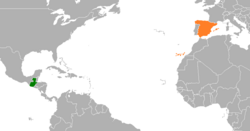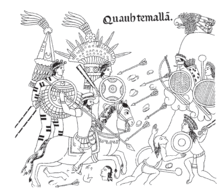Guatemala–Spain relations
 From Wikipedia - Reading time: 10 min
From Wikipedia - Reading time: 10 min
 | |
Guatemala |
Spain |
|---|---|
Relations between Guatemala and Spain date back to 1524, when the modern territory was invaded and conquered by the Spanish. Guatemala achieved its independence in 1821 and established diplomatic relations with Spain in 1863. Both nations are members of the Organization of Ibero-American States and the United Nations.
History
[edit]
Spanish conquest
[edit]The first Spanish troops to arrive to Guatemala were led by Spanish conquistador Pedro de Alvarado in 1524. On arrival to the territory, the Spaniards discovered various peoples of the Mayan and Nahua cultures. The Spaniards, with help of indigenous allies and Tlaxcaltec troops, began to slowly conquer the peoples of Guatemala. The first and major battles involved the Kʼicheʼ people who were defeated in March 1524 and resulted in the capture of the K'iche' capital of Qʼumarkaj.[1] In 1525, Spanish conquistador of the Aztec Empire, Hernán Cortés arrived to Petén to subdue the rebellious Cristóbal de Olid who had been sent to conquer Honduras. Cortés soon returned to New Spain after the battles.[2]
Soon after the conquest of southern Guatemala, the Spanish, in 1557 founded the city Santiago de los Caballeros de Guatemala which was to be the capital of the Captaincy General of Guatemala. Spanish missionaries soon began to Guatemala to convert the native indigenous people to Catholicism. In March 1697, the Spanish fully conquered all of Guatemala for Spain after the conquest of Petén. The Captaincy General of Guatemala became part of New Spain and was governed by the Viceroy of New Spain based in Mexico City.[1]
Independence
[edit]In 1808, Joseph Bonaparte was installed as King of Spain and several Spanish American colonies began to declare their independence from Spain. As Guatemala and most Central American nations were governed by Mexico City; New Spain declared its independence from Spain in 1810. In 1821, the Plan of Iguala which declared Mexico as a constitutional monarchy. Guatemala declared its own independence from Spain on 15 September 1821 and chose to join the Mexican Empire under Emperor Agustín de Iturbide.[3]
In March 1823, Iturbide resigned as Emperor and Mexico became a republic. Guatemala decided to separate from Mexico on 1 July 1823. Guatemala, along with El Salvador, Honduras, Nicaragua and Costa Rica formed the Federal Republic of Central America (with the exception of the Guatemala province of Chiapas which choose to remain part of Mexico in July 1824). In 1839 the Central American Federation dissolved and Guatemala became an independent nation.[3]
Post-Independence
[edit]In May 1863, Guatemala and Spain signed a Treaty of Peace, Friendship and Recognition.[4] During the 1920s, several hundred Spaniards immigrated to Guatemala.[5] In 1960, Guatemala entered into a civil war between the government and various leftist rebel groups supported chiefly by ethnic Maya indigenous people and Ladino peasants. In September 1977, King Juan Carlos I of Spain paid an official visit to Guatemala, his first and only trip as King to the country.[6]
Burning of the Spanish Embassy in Guatemala
[edit]In the early morning of 31 January 1980, a group of Guatemalan peasants from the Committee for Peasant Unity, joined by workers and students, entered the Spanish Embassy in Guatemala City. The protesters announced that they had come to the embassy peacefully and that they would hold a press conference to state their grievances against the Guatemalan government. The protesters choose to enter the Spanish embassy as Spain had been sympathetic towards their cause. At the time the protesters entered, the Spanish Ambassador, Máximo Cajal López was meeting with former Guatemalan Vice-President Eduardo Rafael Cáceres Lehnhoff at the embassy.[7]
The Spanish Ambassador met with the protesters and announced to the government that they hope for a peaceful negotiation to take place. Guatemalan President Fernando Romeo Lucas García and police and government officials immediately met at the National Palace and decided to remove the protesters by force from the embassy. Just before noon that same day, 300 armed state agents surrounded the building and cut the electricity, water and telephone lines. The armed agents entered the building and began to shoot at the protesters who ran to barricade themselves in the various offices. During the commotion, a fire broke out on the second floor of the embassy. As the fire blazed, the police refused to allow volunteers and firefighters to enter the building to save those trapped on the second floor. 37 people died during the fire, including the former vice-president Cáceres Lehnhoff and Vicente Menchú, father of future Nobel Peace Prize laureate, Rigoberta Menchú, as well protesters and Spanish embassy employees. There were only two survivors for the fire, the Spanish Ambassador who narrowly escaped and protester Gregorio Yujá Xona. Both were taken to Herrera Llerandi Hospital for treatment.
On 1 February, 20 armed men entered the hospital and kidnapped Gregorio Yujá Xona. His dead body was later found tortured. On him was a sign stating that the Spanish Ambassador Máximo Cajal López was next. The Ambassador, with assistance from the diplomatic staff left the hospital and fled the country. On 2 February 1980, Spain severed diplomatic relations with Guatemala over the incident at the embassy and the threat on its diplomatic staff.[8][9]
In September 1984, Guatemala and Spain re-established diplomatic relations.[10] In 1999, Rigoberta Menchú presented charges for torture, genocide, illegal detention and state-sponsored terrorism against former President Ríos Montt and four other retired Guatemalan generals, two of them ex-presidents in Spain as Spain's Constitutional Court ruled in 2005 that Spanish courts can try those accused of crimes against humanity even if the victims were not of Spanish origin. In July 2006, a Spanish judge ordered an arrest warrant for Ríos Montt and others accused of genocide.[11]
Bilateral relations
[edit]Guatemala and Spain have signed numerous bilateral agreements and treaties, such as an Extradition Treaty (1895); Agreement on the Protection of Industries and Trade (1925); Agreement on Dual-Nationality (1961); Cultural Agreement (1964); Agreement on the elimination of Tourist Visas (1968); Air Transportation Agreement (1971); Agreement on Technical Cooperation (1977); Agreement on Educational, Cultural and Sports Cooperation (1989) and an Agreement on the Protection of Investments (1999).[4]
Cultural cooperation
[edit]Guatemala hosts a Spanish Cultural Center in Guatemala City and a Spanish Cooperation Training Center in Antigua Guatemala.[12] Likewise, both countries have carried out cultural exchanges with exhibitions on Guatemalan and Spanish culture in their respective museums and galleries, promoting tourism between both societies.[13][14] Twinning agreements have also been processed between several of their respective cities.[15]
Transportation
[edit]There are direct flights between Guatemala and Spain with the following airlines: Iberia and Wamos Air.
Trade
[edit]
In 2018, trade between Guatemala and Spain totaled €369 million Euros.[4] Guatemala's main exports to Spain include: tuna, shrimp, zinc, sugar, rum and coffee. Spain's main exports to Guatemala include: machinery, medicine, food products, electrical equipment and steel. Spain is Guatemala's fifth largest foreign investor (after the United States, Canada, Mexico and Colombia). In 2018, Spanish investments in Guatemala totaled US$31 million.[4] Spanish multinational companies such as Mapfre, Telefónica and Zara operate in Guatemala.
Resident diplomatic missions
[edit]- Guatemala has an embassy in Madrid.[16]
- Spain has an embassy in Guatemala City.[17]
See also
[edit]References
[edit]- ^ a b "History of Guatemala". Archived from the original on 2017-08-24. Retrieved 2017-07-30.
- ^ "The Sacred Horse of the Last Maya Kingdom". Archived from the original on 2018-10-28. Retrieved 2017-07-30.
- ^ a b BBC Timeline: Guatemala
- ^ a b c d Spanish Ministry of Foreign Affairs: Guatemala (in Spanish)
- ^ "Datos sociológicos de la ciudadanía española: Guatemala" (in Spanish). Archived from the original on 2017-08-02. Retrieved 2017-07-30.
- ^ Visita de Estado de Sus Majestades los Reyes a Venezuela, Guatemala, Honduras, El Salvador, Costa Rica y Panamá (in Spanish)
- ^ Guatemala ex-police chief sentenced over embassy attack
- ^ España rompe sus relaciones diplomáticas con Guatemala (in Spanish)
- ^ Guatemala: Spanish Embassy Massacre Trial Begins[permanent dead link]
- ^ España y Guatemala reanudarán sus relaciones diplomáticas a partir del próximo sábado (in Spanish)
- ^ El Caso de Genocidio en Guatemala (in Spanish)
- ^ "CCE/G".
- ^ "Guatemala respira cultura y arte europea de la mano de España". La Vanguardia. 21 July 2015.
- ^ "Guatemala señala como una "inmejorable oportunidad" ser País Socio en Fitur 2023". Europa Press. 12 January 2023.
- ^ "Ciudades de España con las que Guatemala tiene hermanamientos". Guatemala.com.
- ^ Embassy of Guatemala in Spain (in Spanish)
- ^ "Embassy of Spain in Guatemala" (in Spanish). Archived from the original on 2022-01-24. Retrieved 2017-07-30.
 KSF
KSF
